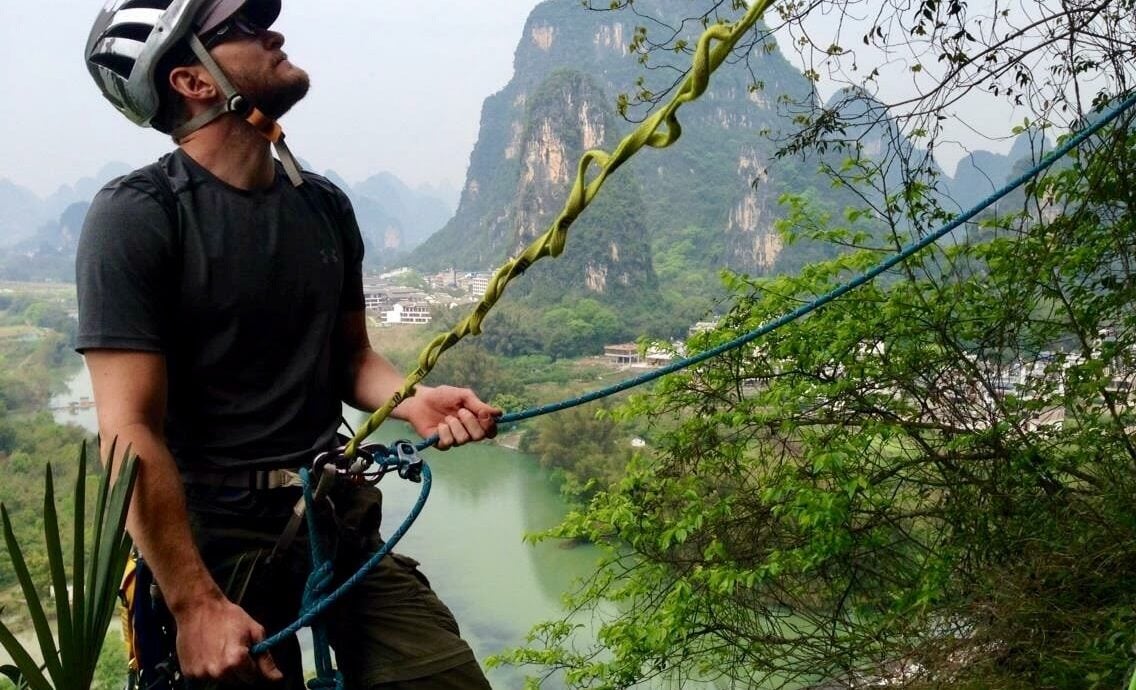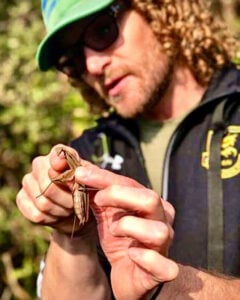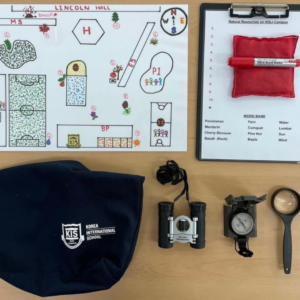
‘If Students Love Nature, They’ll Protect It’: Why Scott Stewart Values Experiential Ed
Educator Highlights . ExplorationIn our Educator Highlights, we discuss ideas and innovation with educators who inspire us. This fall, we’re celebrating Scott Stewart, a program director who designed and implemented a new experiential education program in South Korea.
Scott designs experiential education experiences that promote personal growth and environmental stewardship. Hailing from Michigan, he is a world traveler who has led experiential education programs in the United States and abroad.
We are grateful that Scott spent time sharing his teaching philosophy with us. Learn how Scott makes experiential education part of his school curriculum and download his educational resources for your upcoming place-based activities.
From Nature Explorer to Experiential Educator
Scott spent years leading up to his current role as Experiential Learning Coordinator across all grade levels at Korea International School Jeju (KISJ).
In the “Nature Time” classroom, scorpion models and butterflies dangle from the ceilings and each bookcase offers a wide array of track and scat replicas, nature survival gear, books, geodes and rock ID kits, puppets, animal figures, and more.

Scott Stewart showing students a praying mantis.
Acorn Naturalists: What are some of your early memories of being outside and connecting to nature?
Scott Stewart: I grew up outside of Detroit, about an hour outside in a place called Farmington Hills. We had a big section of woods behind our house, called The Trails. I have so many good memories from exploring with my twin brother, my best friend Brad, and a golden retriever named Nugget.
We’d spend all day long in those woods, building traps, collecting minnows, collecting crayfish, and sledding in the winter. That’s how it all got me started: playing outside.
I should also add that I was obsessed with Nat Geo as a kid. I watched a lot of that with my dad. But it’s hard to know, as an 18-year-old kit, what you want to do with your life. I ended up studying Business Administration and Spanish, but my curiosity for ecology, geology, and education stuck with me.
Funny enough, the management skills I learned from my degree in Business Administration are incredibly valuable skills for running experiential education programs. And as an international educator, knowing Spanish has been key.
Acorn Naturalists: In addition to schooling, what did the wandering path to South Korea entail?
Scott Stewart: So many twists and turns (laughter). Some highlights are the two years I spent living in a tent while leading trail crews for the Nevada Conservation Corps as an Americorps volunteer.
The path also included time as an environmental educator and as an eco-camp director and kayaking guide for Pickering Creek Audubon Society on the Chesapeake Bay. I also spent three years managing Piney Run Nature Center. The latter included caring for 9 raptors, 5 snakes, various turtles, tarantulas, hissing cockroaches, fish, and a hive of bees.
Moving to Ho Chi Minh City marks the start of my career as a teacher in “traditional schools” with my wife, Neyda. Now I’m coming up on nine years of international teaching. For six of those years, I’ve been at Korea International School Jeju (KISJ).
Acorn Naturalists: In one sentence, what do you do at KISJ?
Scott Stewart: I lead all Adventure Days and Field Trips for both the Elementary and Middle school, which amounts to approximately 15-20 trips per quarter!

Suwolbong Geo Trail
Acorn Naturalists: Can you tell us about Jeju Island in South Korea? You lead experiential learning trips out there for your students?
Scott Stewart: Jeju Island is incredible. It has 9 different UNESCO sights and 368 volcanoes–many of which you can climb, as we do on many of our field trips. Students get a break from their iPads and have time to explore while also learning about the natural history of Jeju Island.
On those field trips, students get to experience this gorgeous island and connect with it. And that’s vital. If we can get students to love nature, they’ll protect it.
Acorn Naturalists: How did you build this outdoor excursion program for KISJ?
Scott Stewart: It took years and a lot of logistics. Finding age-appropriate hikes, cultural and historical sites, and itinerary specifics such as “where would we eat lunch and where can these kids poop” took a long time–three years actually.
Acorn Naturalists: What might a field trip to Jeju Island include?
Scott Stewart: Usually it’s based on a science or a social studies standard. First, I’ll meet with the academic team for grade two and see that they’re learning about oceans and aquatic animals. So that helps me plan a field trip that highlights aquatic life and the ocean. Depending on the trip, this could mean studying tidepools for sea urchin and nudibranch or exploring sea cliffs for cormorant and osprey.

Sagye Beach clean-up with students.
Or, let’s say grade three is studying the rock cycle. In that case, we’d head to the West Coast of Jeju Island and hike the Suwolbong Geo Trail. It’s a 2-kilometer-long “volcanic textbook.” There are huge basalt boulders set in cliffs and “volcano bombs” from shooting out basalt ash some 18,000 years ago when the eruption started.
Jeju Island is also a really important place where Haenyeo dive. Haenyeo are women divers, of whom, 90% are over 60 years old. They hold their breath and dive with a knife in hand to collect abalone, conch, clams, mussels, sea cucumbers, sea urchin, and more. They are a vital part of South Korea’s cultural heritage and a real-life example I use to teach students about sustainable fishing, living off the land and appreciating the 10,000 year history of humans existing on Jeju Island.
Acorn Naturalists: That must be really special for students to experience.
Scott Stewart de Moulier: I think it is. Of course, it changes a lot per season, what we can and cannot do. We do about 35 different trips, including long hikes too. All of these outings required me to design and implement the environmental, historical, and cultural curricula.
We had to change the name to “Grit Trips” to make it more appealing for students to step out of their comfort zones. They’re always really proud of themselves once they do it.
Stewart Designed a “Nature Time” Classroom that Students and Teachers Love
Acorn Naturalists: Can you tell us about your “Nature Time” classes?

Tree Scavenger Hunt from @thetravelingnaturalist.
Scott Stewart: Yes, “Nature Time!” Basically, students come into a classroom with diverse nature stations at every table. Our activities vary based on the season and grade level.
The goal of Nature Time is simple: to get students engaged, doing a hands-on activity that helps them build a connection with nature all while having fun.
That classroom is where I use a lot of the resources from Acorn Naturalists. I also use your tools and nature guides to provide direction when students are outside, say, on a tree scavenger hunt.
Acorn Naturalists: Nature scavenger hunt sounds amazing. Do you have more favorite moments from Nature Time?
Scott Stewart: Seeing students so pumped and smiling as they enter the classroom always makes my day. I love when kids are having fun while learning. Because that’s what they’ll remember, at the end of the day: those moments.

Rock and mineral ID station from @thetravelingnaturalist.
One never-fail activity is when I use your track and scat molds and create a map of the KISJ campus. With your track and scat animal replicas, I give them an ID book since they need to ID tracks I’ve placed in four areas around campus. So it requires a bit of wayfinding as well as track ID–and it also builds their communication and discussion skills. They are running around during this and having an absolute blast, not even realizing they are learning.
Acorn Naturalists: How do you define success, as an experiential educator?
Scott Stewart: Hmm… I think it means a lot to see teachers scheduling “Nature Time” as their surprise for students during the day. Because nature is full of surprises.
I also love the fact that the “Nature Time” classroom is a space where students’ joy and excitement for learning happens naturally. To me, that is success.
Follow Scott Stewart for more ideas and inspiration
Educators like Scott remind us that the world is full of people bringing joy and experiential education to the table. And it’s an abundant table at that. Thank you, Scott!
For more, follow Scott Stewart on Instagram, visit his website, and review his downloadable resources, such as the Tree Scavenger Hunt, available for all educators to use, with thanks to Scott.

Leave a Reply